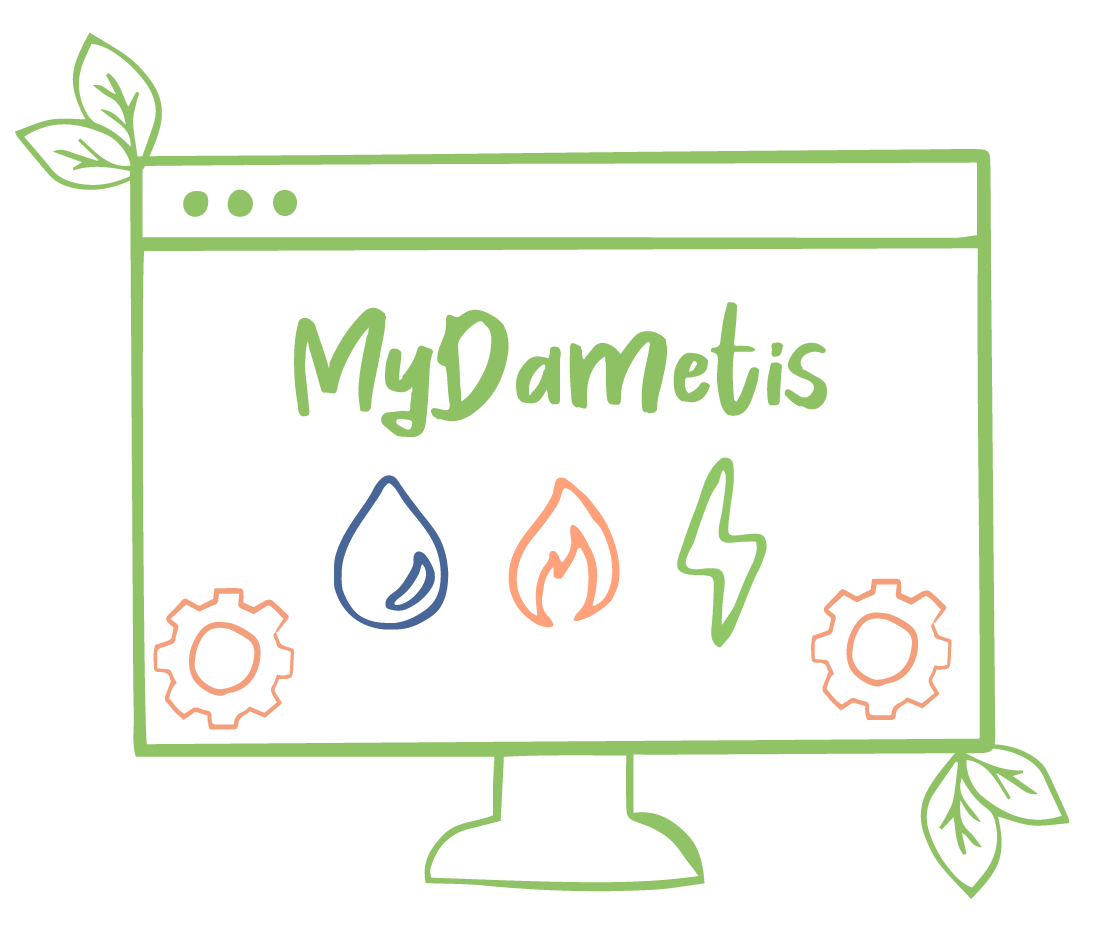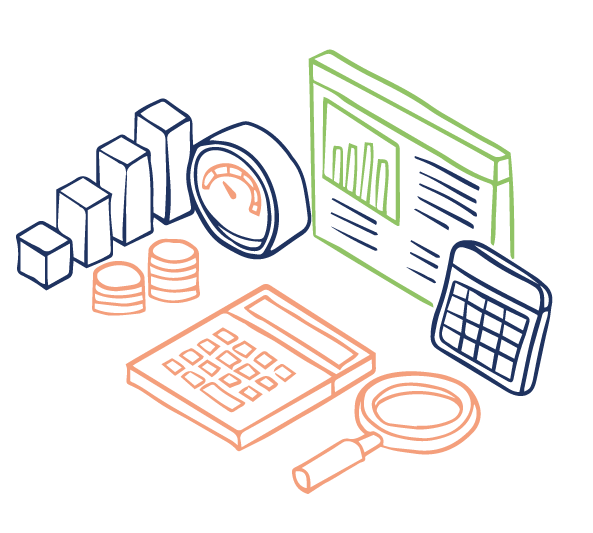Energy Management System (EMS): everything you need to know
EMS stands for Energy Management System, which can be translated as “energy management system”. It is a broad term referring to various possible optimizations within your industry. Dametis supports you to help you achieve your decarbonization goals through the EMS.

What is an Energy Management System?
An EMS software will allow you to optimize the energy consumption of your industry. This tool is linked to sensors that will be placed on your installations, allowing data collection from your factory; you will be able to visualize this data directly from the software interface. This software measures energy consumption at various levels of your industry and correlates these measurements with several indicators such as:
- The carbon impact of the energy used
- The time of day
- Productivity
Depending on the activity, your objectives, and regardless of the scope where the EMS is deployed, it will allow you to monitor a wide range of indicators. For example:
- The energy consumption dedicated to the production of product A compared to that of product B,
- The evolution of energy consumption during maintenance phases,
- The difference in consumption between two similar installations, but from different ranges or generations.
- Etc.

How does an EMS work?

The Energy Management System is a tool that combines the expertise and knowledge of experts with a software platform equipped with a very powerful algorithm.
Thanks to this combination, the Energy Management System will be able to:
-
Collect data from your factory
-
Model and compare your factory to your ideal factory
-
Detect and prevent any anomalies or deviations
-
Recommend solutions to improve your energy efficiency
Within our Energy Management System, MyDametis, your current factory and your ideal factory are referred to as digital twins.
The digital twin operates as follows:
-
It models to monitor your installation – allowing you to stay in control and act quickly in case of failure
-
It models to measure savings – enabling you to take optimization actions and compare the before and after of your installation
-
It models to strive for the optimal installation – helping you quantify your room for improvement
Let’s imagine that your current factory is digital twin A and your ideal factory is B. On twin A, you can observe the behavior of your boiler based on influencing factors. On twin B, for instance, you can simulate a boiler replacement, allowing you to measure the benefits of replacing this boiler.
The gap between the digital twins will then enable you to monitor, measure the room for improvement, quantify the impact of a modification to the physical system.
Digital twins prove to be a significant asset for industrial players; however, it is important to emphasize that this platform operates and proves to be useful thanks to the numerous experts working behind the scenes. These experts develop modules that enable industrial players to have an intuitive, collaborative platform that assists them daily in their profession by displaying data, modeling it, recommending solutions, etc.
Who can use the Energy Management System?
All professions can use an EMS. This tool will allow everyone to gain autonomy and have a precise follow-up of the KPIs of their activity.
The EMS will then bring together all professions at various levels (for example: factory technicians, factory managers, industrial management, IT, finance, and other headquarters professions) thus enabling all employees to rally around energy performance and the environment. Each industry profession will be able to benefit from this EMS to analyze the data that will help them in carrying out their missions on a daily basis, in real time.
The staff will have the opportunity to co-build the tool with the expert and determine the elements to monitor in the EMS. Thus, the tool will be configured so that the data and the various relevant indicators stand out on the interface. The goal is for the person to take ownership of the EMS and its intuitive interface. Once the sensors are installed and the data starts to flow into the tool, the user will know:
- How to analyze them
- Identify anomalies, deviations
- Locate the most energy-intensive parts of the production chain
- Detect instances of energy loss
- Identify a possible technical defect that could cause overconsumption
- Confirm hypotheses by comparing observations with other data
- Validate the receipt of new equipment
- Maintain energy performance

Based on the various conclusions drawn from the analyses, each industry profession will be able to:
– Define the appropriate action plan taking into account
– Economic objectives
– Productivity objectives
– Environmental objectives
– Etc.
– Convince decision-makers to implement these actions
– Actions with budgeted costs
– Actions with predictable impact
– Design and implement new processes by:
– Studying and mobilizing appropriate service providers
– Ensuring that employees are informed and trained in the use of new processes
– Control their energy expenses
– Negotiating energy contracts
– Sustain this continuous improvement approach (such as ISO 50001)
Why install an EMS?
The EMS is a tool equipped with a very powerful algorithm, offering you a multitude of benefits: real-time visibility, drift detection, work recommendations, factory modeling, time saving, simplified implementation of the ISO 50001…
Properly configured, the Energy Management System is able to adapt to your activity, your staff, your objectives, or even your current level of energy performance.
This tool is thus capable of adapting to all energy, water, or material-related professions.
For energy professions, the EMS will be beneficial for: detecting the most energy-intensive equipment, detecting any anomalies (overheating, overconsumption, etc.), implementing corrective actions, or recommending solutions such as improving equipment regulation.
For water professions, this tool will prove to be a valuable ally for: mapping consumption, reducing water consumption, optimizing in-place cleanings (CIP), wastewater treatment plants (WWTP) as well as your treatment chains step by step.
For professions more focused on materials, the EMS will allow you to: identify where material losses come from, reduce them, reduce the extra costs associated with them, or train your teams in material management.More generally, the Energy Management System will allow you to reduce your carbon footprint, reduce your energy bills, reduce your water consumption. This leads to a significant decrease in production unit expenses aiming to move towards the minimum achievable.
Reducing Carbon Footprint with EMS
The Energy Management System allows you to detect energy losses and overconsumption that you can address.
There are many actions that can be implemented to reduce energy consumption using EMS data, on a larger or smaller scale:
- Upgrading an installation to modernize the production chain
- Changing one process for another for better efficiency
- Changing a storage or packaging method
- Switching energy suppliers
- Optimizing the operating times of electrical installations
- Training employees on best practices in the production chain
Cost Reduction
Costs will naturally decrease if you optimize your energy consumption. However, this is not the only way the EMS will contribute to cost reduction in the industry.
The Energy Management System will bring you financial gains by determining influential factors:
- Reducing malfunctions in facilities through predictive maintenance based on consumption
- Reduction in repair costs
- Uninterrupted production
- Elimination of employee waiting time to resume production on the line
- Reduction of non-compliances, which will help you avoid potential legal conflicts
- Access to subsidies related to ecological commitment
Increased Productivity
Finally, the EMS will allow you to increase productivity, which represents both a financial gain and a benefit for the well-being of employees. This increase in productivity can be characterized by:
- Optimization of the supply chain
- Reduction of unproductive operational times
- Uninterrupted production thanks to predictive maintenance
- A smoother and often facilitated workday
The steps to install an Energy Management System
The final step is to ensure that you will be supported by an expert. This can be done through training on the use of your EMS by the installing organization or through ongoing external support.
Avoiding pitfalls when implementing an EMS
There are several precautions to consider before installing an EMS:
- Define preliminary objectives to have a tool configuration tailored to your needs
- Define the technical uses to be monitored
- Daily or monthly preferences
- Key performance indicators to include
- Prepare the list of existing measures
- Develop a Measurement Plan (PDM) to recommend additional measures and discuss the total budget according to requirements
- Ensure real-time data monitoring over time
- Be supported by a designated and trained person
- Have a real-time measurement plan – actual data
Dametis advises you on the devices to prioritize monitoring. Some companies choose to implement their Energy Management System in stages.
The benefits of using an EMS software
Why use an EMS instead of other decarbonization solutions, such as regular audits with manual measurements?
An EMS software offers several long-term advantages. Once implemented in your factory, the software allows for continuous improvement of your facilities, eliminating the need for a complete site production audit. However, it may be necessary to add new sensors when replacing a part of the production chain.
Furthermore, the Energy Management System interface is simple, intuitive, and enables data compilation to visually and interactively display improvements over time. This allows you to showcase your company’s progress to your employees, management, or potential clients and investors.

Dametis supports you in decarbonizing your industry!
Dametis experts help you identify optimization opportunities for your production chain. This may involve implementing the My Dametis EMS software and receiving consulting support.
But Dametis’ expertise goes beyond that, we also offer energy audits in industry, environmental performance consulting, and energy industry training provided by experts from the Dametis Academy.








